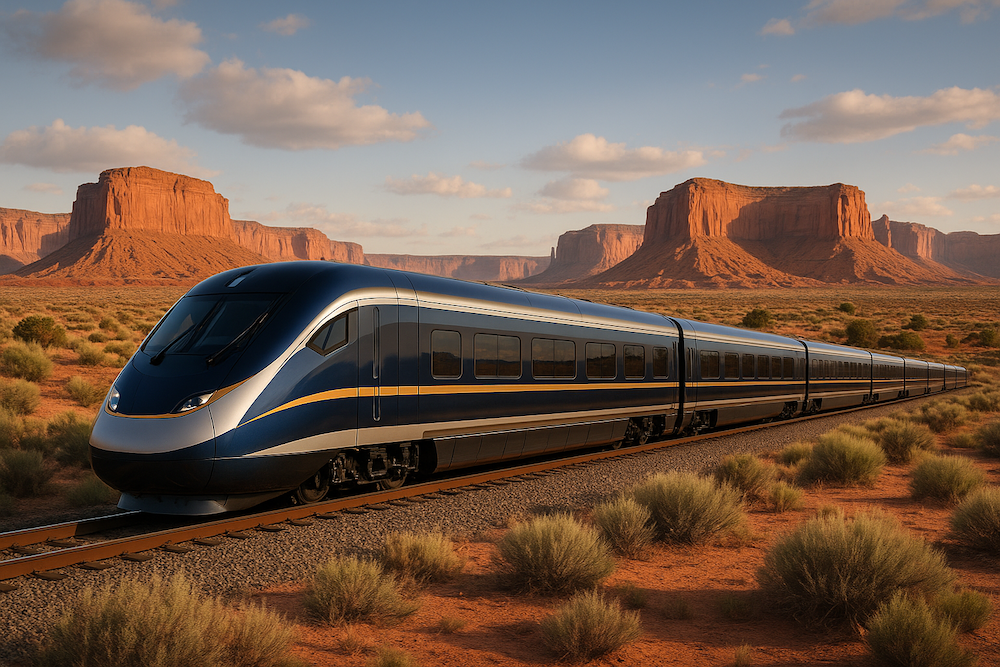A new transcontinental train proposal promises scenic group travel, auto transport, and even onboard lounges—but can it actually deliver?
If the stars align—and freight railroads, Amtrak, and private investors all play ball—AmeriStarRail may soon offer meeting and incentive planners something the U.S. hasn’t seen in generations: a private, coast-to-coast rail service designed not just for travelers, but for trucks, autos, and group business.
The concept, dubbed The Transcontinental Chief, was pitched in late June to Amtrak, the White House, the U.S. Department of Transportation, and congressional leaders as a privately funded, 72-hour cross-country rail line. The train would run from Hoboken, New Jersey, to Los Angeles Union Station, linking and extending existing Amtrak routes.
Designed for launch in May 2026, the train would coincide with two massive events: the FIFA World Cup and the United States’ 250th Independence Day celebration. AmeriStarRail positions it as a timely contribution to a pivotal national moment. “This is a unique opportunity,” said COO Scott Spencer in the company’s June 30 letter, “to tie our nation together for its 250th birthday.”
But beyond the patriotic timing, the proposal has real implications for business event strategists seeking alternatives to air travel, overbooked hotels, and fragmented logistics.
A Rolling Venue—and a Logistics Machine
AmeriStarRail’s vision blends passenger mobility with logistical muscle. The Transcontinental Chief wouldn’t just transport travelers in coach and sleeper accommodations—it would also allow personal vehicles, motorcycles, and even RV campers to be loaded onboard in Auto Train fashion. At the same time, specially designed flatbed railcars would accommodate full tractor-trailers, allowing truck drivers to comply with mandated rest hours while still making progress toward their destinations.
This multi-layered approach transforms the train into a “rolling truck stop, car ferry, and hotel on rails,” according to Spencer. The company sees it as a direct solution to the growing shortage of truck parking in the U.S., while also offering event planners a self-contained, mobile base for touring activations, crew movement, or high-end incentive programs.
The route would run on existing infrastructure owned by BNSF and Norfolk Southern, with trainsets composed of refurbished Amtrak Superliner cars, upgraded to modern standards. ASR notes that this model avoids the cost and complexity of building high-speed rail from scratch. Spencer emphasized in multiple interviews that this is about efficiency over novelty: “We’re using private money, and I hope whether people ride the train or not, they can be excited about that.”
Amtrak, Freight Rails, and a Tight Clock
Despite the proposal’s appeal, significant challenges remain—and time is not on AmeriStarRail’s side.
The project hinges on multiple partnerships: Amtrak would need to grant access to equipment, facilities, and its statutory track rights, while freight railroads must approve the use of their infrastructure. Although the Federal Railroad Administration confirmed it is reviewing the proposal, Amtrak has so far declined to comment publicly.
The question of capacity, prioritization, and operational coordination on freight-owned lines looms large. Past attempts to mix passengers and freight on shared tracks have led to reliability issues—something ASR claims it has solved through streamlined terminal operations and advanced scheduling.
“The Transcontinental Chief is designed to load and unload trucks in a NASCAR-style pit stop,” Spencer told Railway Age. “This isn’t mail-and-express from the 1990s. We’ve learned from that.”
Then there’s the clock. The company aims to launch the service by May 10, 2026—just nine months from now. That gives AmeriStarRail limited time to negotiate access, refurbish equipment, construct roll-on/roll-off terminals, and market the service to freight and passenger customers. It’s an ambitious schedule for any infrastructure project, let alone one that spans 2,500 miles.
What It Could Means for Meetings & Incentives
If it launches on time—and performs as promised—the Transcontinental Chief could offer event strategists a rare combination of scale, flexibility, and wow factor.
Instead of booking multiple planes and buses, planners could move groups, staff, equipment, and even tour vehicles in one self-contained operation. A marketing team could board in Chicago, set up client events in Albuquerque, and wrap in Los Angeles—all while sleeping in bunks, holding client dinners in a dining car, and hauling AV gear in a freight carriage two cars down.
For incentive travel, the experience could rival a luxury cruise—think sales winners boarding in Hoboken with their own vehicles and arriving in California three days later for a coastal road trip, minus the TSA lines or baggage claim chaos.
More broadly, the train could provide a more sustainable, more customizable, and less chaotic alternative to flying—particularly attractive during periods of air traffic congestion, weather delays, and lost luggage frustrations that plague the current system.
And for World Cup or Semiquincentennial events, the rail line could offer organizers and sponsors a high-visibility platform to activate national campaigns across multiple cities with one unified mode of transport.
Proceed with Caution—and Curiosity
The Transcontinental Chief is not yet real. It needs Amtrak, freight railroad cooperation, regulatory clearance, and rapid execution. But it’s also one of the only serious proposals for long-distance passenger rail expansion that doesn’t require government subsidies or years of new track construction.
For planners, it’s too early to book—but not too early to watch.
If the train gets rolling, it won’t just be a novelty. It might be the most flexible new tool the meetings and incentives industry has seen in decades.
Any thoughts, opinions, or news? Please share them with me at vince@meetingsevents.com.
Image generated by AI using OpenAI’s DALL·E





